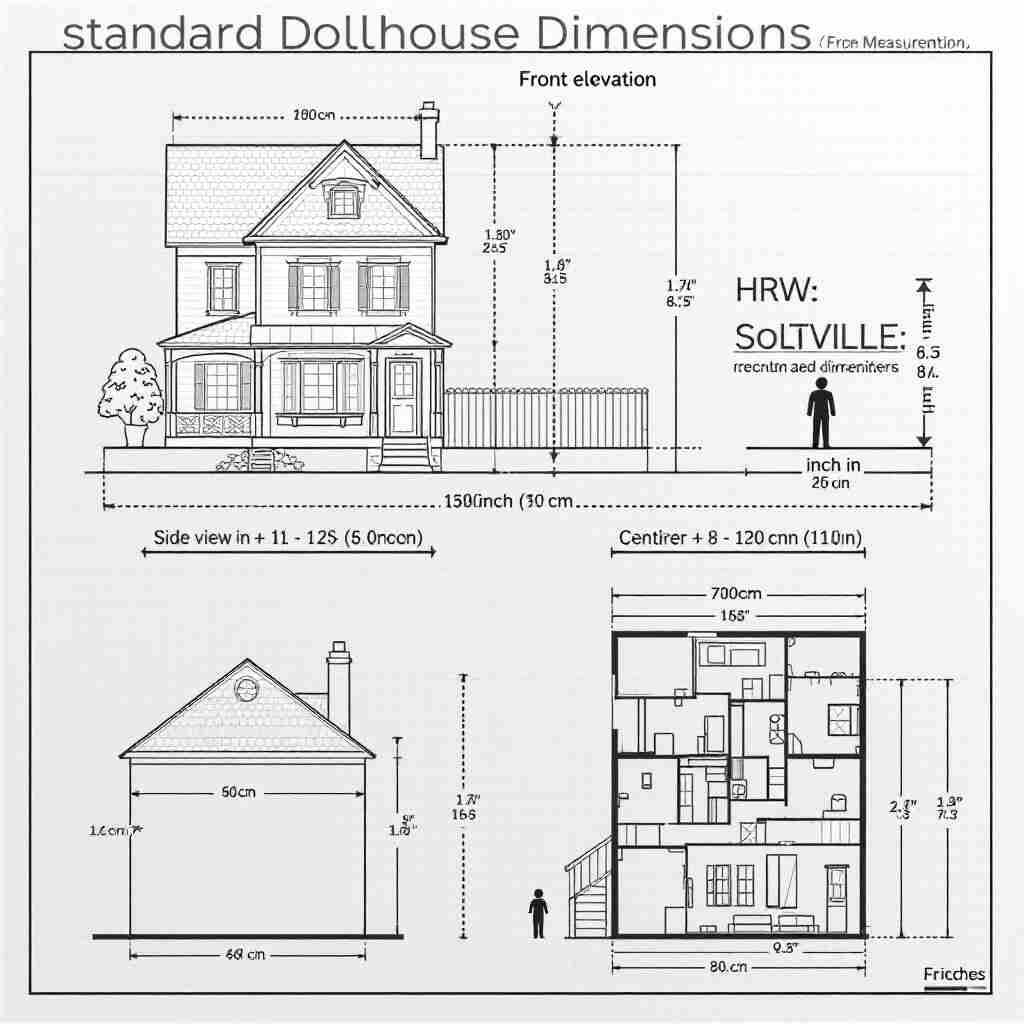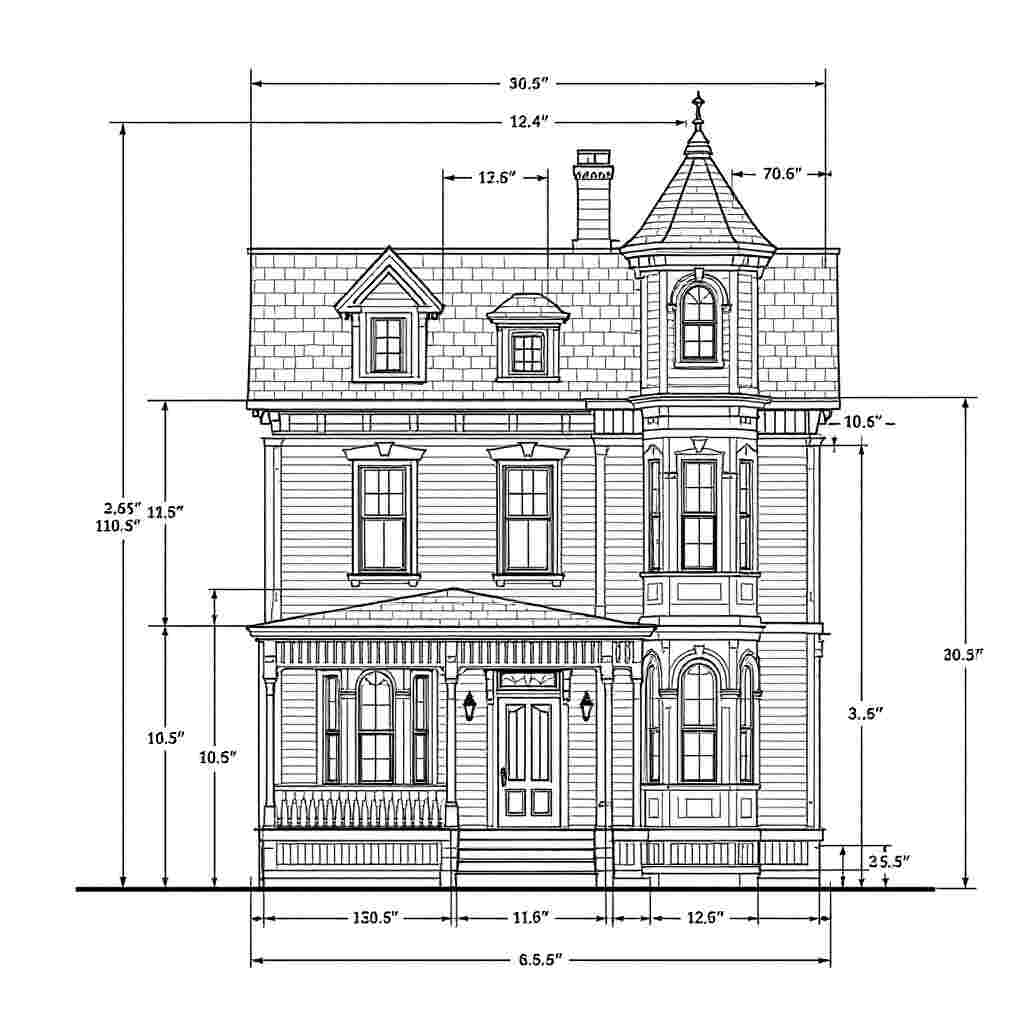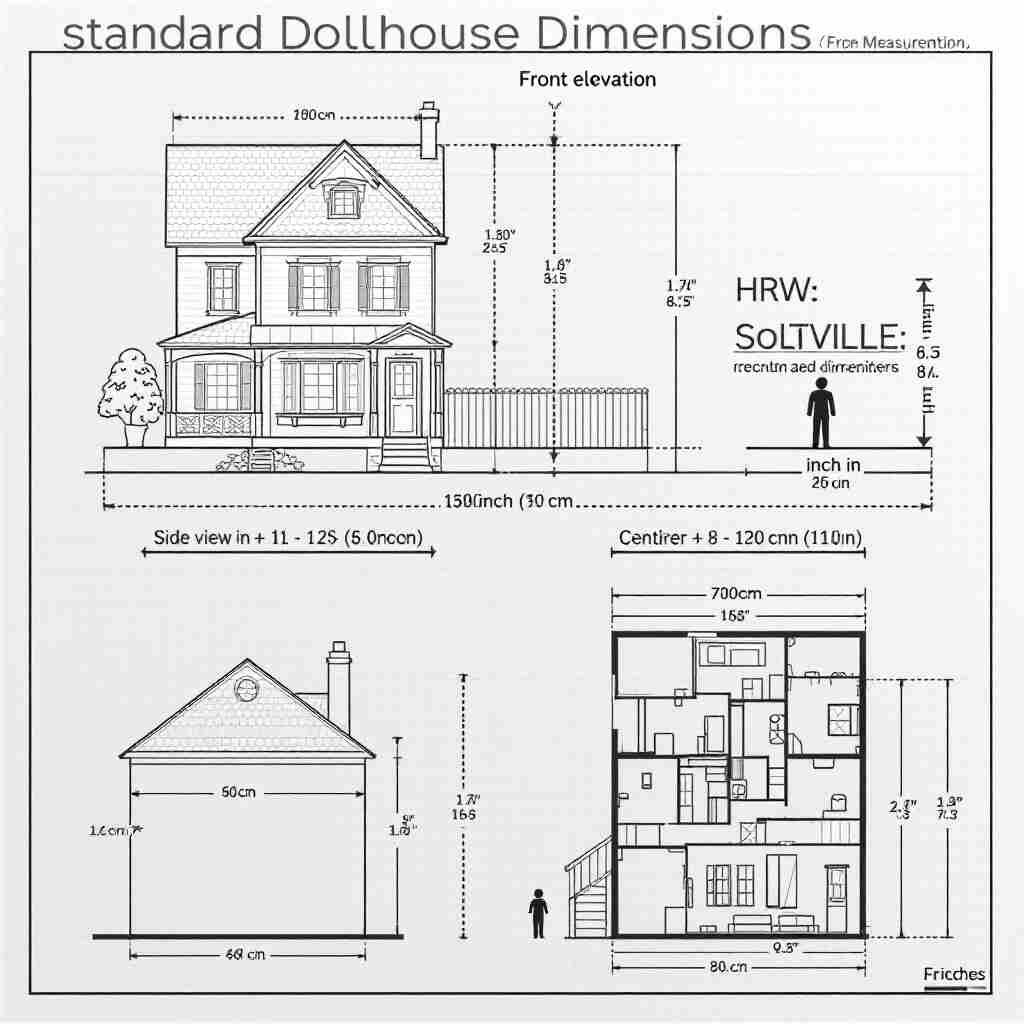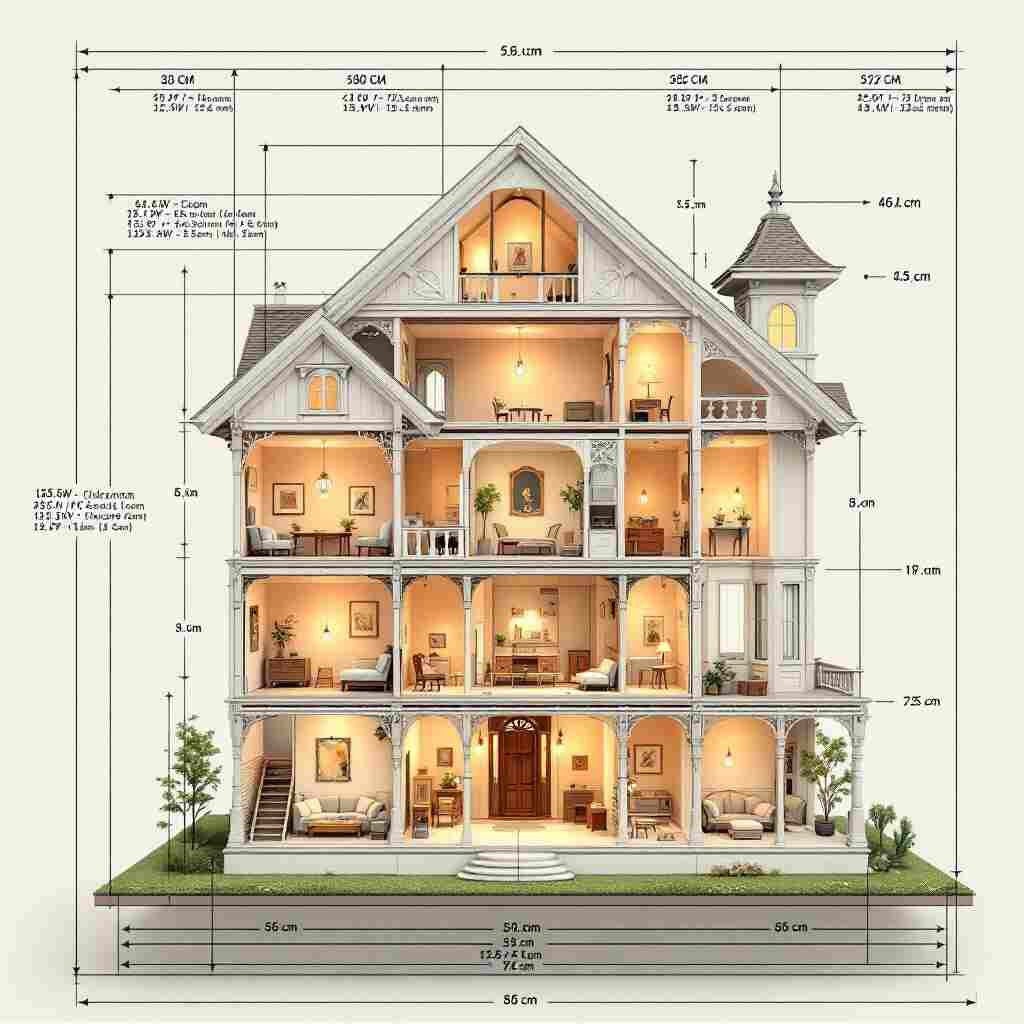Dollhouses have been a beloved hobby for generations for collectors, children, and hobbyists alike. Whether you’re a child setting up a dream miniature home or an adult collector crafting detailed replicas, understanding doll house dimensions is crucial. It ensures your dollhouse is realistic, functional, and fits your intended purpose—whether for display or play.
| Scale | Description | Typical Doll Size | Example Dimensions |
|---|---|---|---|
| 1:6 | Fashion Doll Scale | 30 cm (12 inches) tall | Large, often over 2 feet tall |
| 1:12 | One-Inch Scale | 15-20 cm (6-8 inches) tall | Common for children’s houses, e.g., 30-60 cm wide, 40-80 cm tall |
| 1:16 | 3/4 Scale | 9-13 cm (3.5-5 inches) tall | Smaller than 1:12, e.g., 20-40 cm wide, 30-60 cm tall |
| 1:18 | 2/3 Scale | Similar to 1:16 | Lundby houses, similar dimensions to 1:16 |
| 1:24 | Smaller Scale | 6-9 cm (2.5-3.5 inches) tall | Smaller houses, e.g., 15-3 |
What Are Doll House Dimensions?
Dollhouse dimensions refer to a dollhouse’s height, width, depth, and room sizes. These measurements determine the overall size of the dollhouse and its individual components. For example, a dollhouse could measure 24 inches in height but only 12 inches in depth, influencing its appearance and usability.
Why Are Dimensions Important?
- Realism and Functionality: Accurate dimensions replicate real-life proportions, adding a sense of realism to your miniature world.
- Furniture Fit: The dimensions of your dollhouse dictate the size of the furniture and accessories you can use.
- Space Planning: Understanding the dimensions helps you decide where to place the dollhouse in your home and ensures it fits your available space.
One of the key aspects of dimensions is their relationship with scales, which we’ll explore in the next section.
Understanding Dollhouse Scales
Dollhouse scales are ratios that indicate the size of the dollhouse in comparison to real-life objects. For example, a 1:12 scale means that 1 inch in the dollhouse equals 12 inches in real life. Scales are critical in determining how furniture, dolls, and accessories fit within the dollhouse.
You may Also read ( rewire a 1500 sq ft house)
What Are Dollhouse Scales?
Scales simplify the process of creating miniatures. They allow hobbyists and manufacturers to produce proportional furniture and accessories that fit perfectly within the dollhouse. Without standardized scales, it would be challenging to find matching pieces.
Popular Dollhouse Scales
Here’s an overview of the most common dollhouse scales:
ScaleDescriptionWho Uses It?
1:12 Most popular scale; 1 inch = 1 foot in real life. Collectors, miniaturists, and hobbyists
1:6 Larger scale, ideal for fashion dolls like Barbie. Children and Barbie collectors
1:24 Half the size of 1:12; great for compact spaces. Hobbyists with limited space
1:48 A very tiny scale, also known as “quarter scale.” Advanced miniaturists
Choosing the Right Scale
When selecting a scale for your dollhouse, consider these factors:
- Space Availability: Larger scales like 1:6 require more room, while more minor scales like 1:48 are compact and space-saving.
- Intended Use: If the dollhouse is for a child, a 1:6 scale might be better as it’s easier for small hands to handle. For collectors, 1:12 is often the preferred choice.
- Age Group: Smaller scales can be more delicate, making them less suitable for younger children.
How to Measure Doll House Dimensions
Measuring a dollhouse is essential whether you’re buying, building, or customizing one. Follow these steps to ensure accuracy:
Step-by-Step Guide
- Overall Dimensions: Measure the entire dollhouse’s height, width, and depth using a measuring tape.
- Room Measurements: Measure each room individually, including:
- Height: Distance from floor to ceiling.
- Width: Distance between side walls.
- Depth: Distance from the front wall to the back wall.
- Special Features: Don’t forget to measure areas like attics, hallways, or balconies.
Tips for Accuracy
- Use a ruler or measuring tape with clear markings.
- Double-check your measurements to avoid errors.
- Keep a notebook handy to document the dimensions for future reference.
Impact of Materials on Dimensions
The materials used to construct a dollhouse can influence its dimensions. For instance, thicker materials may result in slightly smaller interior spaces.
Common Materials
- Plywood: Durable and lightweight, plywood is a popular choice for dollhouses. It’s easy to cut and shape but can increase the overall weight.
- MDF (Medium-Density Fiberboard): Heavier and denser than plywood, MDF is great for intricate designs but may reduce interior space slightly due to its thickness.
Durability Considerations
- Thicker Materials: Provide better durability but reduce usable space.
- Thinner Materials: Allow for larger interiors but may be less durable.
Room Dimensions in Doll Houses
The size of individual rooms is crucial for functionality and realism. Here’s a breakdown of typical room dimensions based on scale:
Room Type1:12 Dimensions (in inches)1:24 Dimensions (in inches)
Living Room 10 x 12 5 x 6
Kitchen 8 x 10 4 x 5
Bedroom 9 x 10 4.5 x 5
Hallways 4 x 8 2 x 4
Room sizes vary depending on the dollhouse’s design style, such as Victorian, modern, or rustic themes.
Why Doll House Dimensions Matter
Proportionality
One of the biggest reasons dimensions matter is ensuring proportionality. Furniture, dolls, and accessories must match the scale of the house. For example:
- A 1:12 dollhouse should have furniture that is also a 1:12 scale.
- Mismatched scales can disrupt the overall aesthetic and functionality.
Realism
Accurate dimensions contribute to a lifelike appearance. Realism is often collectors’ primary goal; precise measurements can make or break a project.
Customizing Doll House Dimensions
Customizing a dollhouse allows you to add unique touches that reflect your personality or interests.
Tips for Customization
- Adjust Room Sizes: Expand or shrink rooms to fit specific furniture or themes.
- Create Unique Themes: Adjust dimensions by designing a Victorian mansion, a modern loft, or a rustic cabin.
- Scaling Up or Down: Use scale conversion tools to modify dimensions for your desired scale.
Common Challenges with Doll House Dimensions
Many hobbyists face challenges when working with dollhouse dimensions. Here are some common issues and solutions:
Challenges
- Mismatched Furniture Sizes: Finding furniture that fits ideally can be tricky.
- Limited Accessories: Certain scales, like 1:48, may have fewer options.
Solutions
- Use online guides and calculators to ensure accurate scaling.
- Purchase from specialized retailers that offer scaled furniture and accessories.
Doll House Dimensions for Beginners
If you’re new to dollhouses, here’s some advice to make your journey easier:
- Start with Standard Scales: 1:12 or 1:6 scales are beginner-friendly and widely available.
- Buy Pre-Designed Kits: Many kits come with precise dimension specifications, making them an excellent option for beginners.
- Focus on Simplicity: Avoid overly complex designs when starting.
Advanced Tips for Miniaturists
For advanced collectors and hobbyists, here are some ideas to take your dollhouse to the next level:
- Create Period-Specific Houses: Research historical architecture to design accurate replicas of Tudor, Victorian, or Art Deco homes.
- Experiment with Themes: Build themed dollhouses, such as beach cottages, city apartments, or fairytale castles.
Frequently Asked Questions About Doll House Dimensions
- What is the most common dollhouse scale?
- The 1:12 scale is the most popular among collectors and hobbyists.
- Can I mix furniture from different scales?
- Mixing scales is not recommended, as it can disrupt the proportionality and realism.
- How do I measure my dollhouse accurately?
- Use a measuring tape to measure the overall height, width, depth, and individual room sizes.
- What materials are best for constructing dollhouses?
- Plywood and MDF are popular choices due to their durability and ease of use.
Conclusion
Understanding doll house dimensions is the foundation of creating a functional and realistic dollhouse. Whether you’re a beginner or an advanced hobbyist, knowing the importance of scales, measurements, and materials will help you create the perfect miniature home.
So, what are you waiting for? Start exploring different scales, get creative with customization, and share your dollhouse projects with the world! Do you have questions or want to share your tips? Let us know in the comments below.
You may Also read (locksmith open house door)
